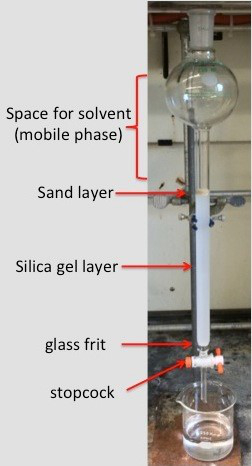Cromatografia su colonna
Fonte: Laboratorio del Dr. Jimmy Franco - Merrimack College
La cromatografia su colonna è una delle tecniche più utili per purificare i composti. Questa tecnica utilizza una fase stazionaria, che è impacchettata in una colonna, e una fase mobile che passa attraverso la colonna. Questa tecnica sfrutta le differenze di polarità tra i composti, permettendo alle molecole di essere facilmente separate. 1 Le due fasi stazionarie più comuni per la cromatografia su colonna sono il gel di silice (SiO2) e l'allumina (Al2O3), con le fasi mobili più comunemente utilizzate come solventi organici. 2 Il solvente o i solventi scelti per la fase mobile dipendono dalla polarità delle molecole da purificare. Tipicamente più composti polari richiedono più solventi polari per facilitare il passaggio delle molecole attraverso la fase stazionaria. Una volta completato il processo di purificazione, il solvente può essere rimosso dalle frazioni raccolte utilizzando un evaporatore rotante per produrre il materiale isolato.
1. Liquame di gel di silice
- Versare il gel di silice in un matraccio Erlenmeyer. Il peso del materiale d'imballaggio deve essere circa 50 volte quello del campione da separare. Se i composti separati hanno valori Rf molto simili, potrebbe essere necessario utilizzare una maggiore quantità di silice per campione, come nel caso di questo esempio.
- Posizionare 10 g di silice nel matraccio Erlenmeyer, poiché 50 mg di campione (45 mg di fluorenone e 5 mg di tetrafenilporfirina) vengono is
Il campione contenente una miscela di tetrafenilporfirina (TPP, 5 mg) e fluorenone (45 mg) è stato separato con successo e ciascun composto è stato isolato. Il TPP eluiva prima la colonna come una banda viola-rossastra scura e il fluorenone successivamente eluiva dalla colonna come una banda gialla (Figura 2). Le frazioni eluite sono state raccolte in provette e identificate dai loro colori distintivi (Figura 3). Le frazioni contenenti ..
Sommario
La cromatografia su colonna è un metodo conveniente e versatile per purificare i composti. Questo metodo separa i composti in base alla polarità. Sfruttando le differenze nella polarità delle molecole, la cromatografia su colonna può facilmente separare i composti dalla velocità con cui i composti attraversano la fase stazionaria della colonna. Uno dei vantaggi della cromatografia su colonna (specialmente se confrontato con la ricristallizzazione) è che molto p...
- Mayo, D. W.; Pike, R. M.; Forbes, D. C., Microscale organic laboratory : with multistep and multiscale syntheses. 5th ed.; J. Wiley & Sons: Hoboken, NJ; p xxi, 681 p (2011).
- Armarego, W. L. F.; Chai, C. L. L., Purification of laboratory chemicals. 5th ed.; Butterworth-Heinemann: Amsterdam; Boston; p xv, 609 p (2003).
- Silverman, R. B.; Holladay, M. W., The organic chemistry of drug design and drug action. Third edition / ed.; Elsevier/AP, Academic Press, is an imprint of Elsevier: Amsterdam ; Boston; p xviii, 517 pages (2014).
- Mortensen, D. S.; Perrin-Ninkovic, S. M.; Shevlin, G.; Elsner, J.; Zhao, J.; Whitefield, B. et. al. Optimization of a Series of Triazole Containing Mammalian Target of Rapamycin (mTOR) Kinase Inhibitors and the Discovery of CC-115. Journal of Medicinal Chemistry (2015).
- Davies, D. R.; Johnson, T. M., Isolation of Three Components from Spearmint Oil: An Exercise in Column and Thin-Layer Chromatography. Journal of Chemical Education,84 (2), 318 (2007).
- Taber, D. F.; Hoerrner, R. S., Column chromatography: Isolation of caffeine. Journal of Chemical Education, 68 (1), 73 (1991).
Vai a...
Video da questa raccolta:

Now Playing
Cromatografia su colonna
Organic Chemistry
358.3K Visualizzazioni

Introduzione alla catalisi
Organic Chemistry
34.1K Visualizzazioni

Assemblaggio di un sistema a riflusso per reazioni chimiche riscaldate
Organic Chemistry
166.2K Visualizzazioni

Esecuzione di reazioni al di sotto della temperatura ambiente
Organic Chemistry
70.3K Visualizzazioni

Trasferimento di solventi tramite linea Schlenk
Organic Chemistry
41.5K Visualizzazioni

Degasaggio di liquidi con ciclo freeze-pump-thaw
Organic Chemistry
55.9K Visualizzazioni

Preparazione di reagenti anidri e relativa strumentazione
Organic Chemistry
79.1K Visualizzazioni

Purificazione di composti tramite ricristallizzazione
Organic Chemistry
705.2K Visualizzazioni

Separazione di miscele tramite precipitazione
Organic Chemistry
157.2K Visualizzazioni

Estrazione solido-liquido (lisciviazione)
Organic Chemistry
237.0K Visualizzazioni

Rimozione dei solventi con evaporatore rotante
Organic Chemistry
212.3K Visualizzazioni

Distillazione frazionata
Organic Chemistry
332.8K Visualizzazioni

Preparazione di cristalli per l'analisi mediante diffrazione dei raggi X
Organic Chemistry
32.3K Visualizzazioni

Performing 1D Thin Layer Chromatography
Organic Chemistry
288.3K Visualizzazioni

Spettroscopia a risonanza magnetica nucleare (NMR)
Organic Chemistry
246.7K Visualizzazioni
